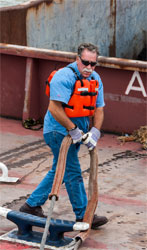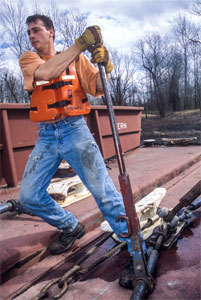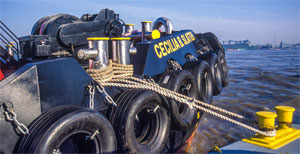A proposal to standardize towing lingo raised the temperature in the room at this year’s Towing Safety Advisory Committee (TSAC) meeting. The gathering, attended by members of both the tugboat and towboat sectors of the towing industry, was held at the old Customs House building at New York City’s maritime rich Battery Park.
The idea was to create a Task Statement titled “Recommendations to Create Standardized Terminology for the Towing Industry.” The discussion brought to the forefront the differences in culture and environment between mariners working on the ocean and in harbors, and those who work on the nation’s rivers. Mariners love their regional and cultural words used to describe universal things, and the debate over corralling each cluster of terms to describe the same thing and to render them to one proved the point.
A consensus in terminology involving the tugboat industry on the nation’s three coasts seemed difficult enough, but the divide between the tugboaters and the towboaters is as significant as the difference between bluewater and brownwater.
 |
|
A deck hand aboard Buckeye State faces up a tow to what the towboat industry calls a cavel, otherwise known as a cleat. |
The opening paragraph of the “Discussion” portion in the Task Statement proposal states: “As the Towing Industry moves toward ‘inspected vessel’ status, the standardization of definitions becomes an important and integral part of the safe operation and administration of towing vessels. The cornerstone of any Safety Management Systems depends upon clearly identifying and defining terms used in daily operations.”
Making the presentation was Capt. Eric Johansson, a professor at the State University of New York Maritime College. Johansson was speaking for a core group of maritime academies and towing companies, including Kirby Inland Marine, that began discussing the subject about six years ago. The can of worms was opened.
Johansson is also the founder of the Towing Forum, an annual gathering of the tugboat and towboat clans at SUNY’s Maritime College campus at Fort Schuyler, on Throgs Neck in the Bronx.
It was at the 2008 Towing Forum that the process of formulating a standard terminology for the towing industry was begun, largely based on Kirby Inland’s manual. “Over the years I’ve found that so many different people have so many different names for so many different parts of a vessel,” Johansson said. “And in reading books about the towing industry, there were a lot of issues with that as well. I thought, well, let’s come up with something to minimize ambiguity, be more professional and safe and allow the Coast Guard to identify things in a clear manner for their reporting. Kirby (Inland Marine) has done a very nice job of towboat nomenclature. We took their model and applied it to tugboats.”
The participants at the 2008 meeting included representatives from most of the major U.S. towing companies on the East and Gulf coasts. Also attending were people from Maine Maritime Academy, Massachusetts Maritime Academy, the National Maritime Center, the U.S. Merchant Marine Academy and the Coast Guard.
Two years later, at the 11th annual Towing Forum, Johansson presented the result of the project to date, in a paper entitled “Standardization of Towing Nomenclature,” a collection of terms arrived at by consensus among the participants.
“It came to the point that all of the local companies here in New York as well as Kirby and G & H Towing in Houston participated. We also had Maine Maritime, Mass Maritime, Kings Point and us (SUNY) on board. Cal Maritime was interested but couldn’t make it,” he said. “We are looking to set up a clear definition of terms that is applicable and acceptable to the marine industry, the boat crews and the Coast Guard.”
The various maritime academies agreed that they would begin teaching the same terminology to the cadets. “The cadets have become a big part of our industry now, regardless of what school, because of the demand for licensing and paperwork in our industry,” said Johansson. “The maritime companies are doing more recruiting at the academies, so we thought it was important that the schools teach the same things.”
Originally the intention was to publish the “Standardization of Towing Nomenclature” in book form, creating yet another lexicon of nautical terms, albeit one void of competing terms. “But it was felt that the book would just end up on the shelf,” said Johansson.
“The participants in the project decided that, in today’s maritime world, the subject was too important to sit on bookshelves. What we decided to do is, instead of publishing them, it would be best to put this as a Task Statement to TSAC to be voted on by the membership at the New York meeting.”
 |
|
Capt. Eric Johansson, professor at SUNY Maritime College, is the founder of the Towing Forum. Johansson spearheaded the effort to standardize terms used in the industry. |
Ensconced in his office, deep in the stone walled pentagon of Fort Schuyler a couple of days before this year’s TSAC meeting, Johansson was fine-tuning the Task Statement document. The tasks portion reads as follows:
“Establish a subcommittee to include a diverse regional representative body, a broad scope of towing vessel operators and include licensed officers and engineers with full time vessel operating responsibilities.
“Develop a towing industry terminology index to include definitions.
“Publish a draft version of this terminology index and definitions on the USCG HOMEPORT site to solicit comments from industry.
“Make final recommendations to the Coast Guard to adopt standardized definitions.
Provide other recommendations as appropriate relevant to this Task but not specifically identified.”
“Now, whatever we do is a recommendation to the Coast Guard,” said Johansson. “They don’t have to do it. TSAC is an advisory committee, but I’m hoping that the Coast Guard will strongly consider this because if the industry is using the same words, then that will make for better safety. It is the basis of a Safety Management System (SMS) to have a clear definition of terminology so that we can all understand what we are talking about. Definitions are the foundation of an SMS.”
When asked about the Coast Guard’s involvement, Patrick Mannion, the alternate designated federal officer on TSAC, stated, “That was the purpose of the Coast Guard working with the Towing Safety Advisory Committee to bring this Task Statement before the full Towing Safety Advisory Committee. There was an articulated need from industry regarding Coast Guard oversight activities and to promote greater consistency of merchant mariner cadet training purposes.”
Another of the issues stemming from ambiguity is in Coast Guard incident and casualty reporting. During the meeting, virtually every committee that presented Task Statements with recommendations to the Coast Guard stressed that their efforts to evaluate and formulate those recommendations were severely hampered by confusing reports with insufficient information.
The nature of Coast Guard personnel being transferred about the country every few years, and writing up their reports based on regional or towing sector terminology that is based on individual, regional and sector differences, was sited as contributing to the confusion.
“You want to eliminate that ambiguity because the Coast Guard will be doing more inspections and writing more reports as we move towards ‘inspected status,’” said Johansson. “So things should be clear for them and for the industry. The best way to get safe is to study what went wrong: lessons learned, corrective actions.”
 |
|
This crewman uses a ratchet, or turnbuckle, to cinch up the barge wires to a cavel, on the bottom right. |
Johansson pointed out that if a report indicates a corrective action was taken, for example, by the crew of a tug in trouble on the West Coast, readers on the East Coast have to understand what that action was. “Not only is this important to company Safety Management Systems, but when the Coast Guard does report to the industry, the key is for them to identify something that everyone can understand. That’s a big part of this. Old habits are hard to break, but we have to make a start.”
The Coast Guard’s Mannion addressed the issue. “For the Towing Safety Advisory Committee, the Coast Guard views this Task Statement as having value because it is promoting uniformity and consistency and, as a result, greater clarity for both the industry and the Coast Guard for regulatory oversight and investigations and enforcement purposes,” he said.
With “inspected status” on the near horizon, some of the confusion that now reigns will be lessened by, for example, more clearly defined fire and emergency response plans. According to Johansson, clearly defined plans will be reflected in a company’s policies and procedures and clearly defined areas of the vessel in regard to responding to fires and other emergencies.
“It’s important that those areas are consistent throughout the industry,” said Johansson. “I would prefer that people stick to a simple standard with the main deck being 00 and every deck being numbered upward, 01, 02, 03 and up. Pretty simple. Sometimes people will call different parts of the vessel by different names. That should not be, because you may have a new crewmember on board, and during a fire they go to the wrong area because they’re from a company that called that area something else.”
Then there is the battle of the bitts. The bitt lineup, as arrived at by the committee and named from stem to stern is “stem, button, side, amidships and quarter bitts.” A bow H bitt and a stern H bitt were left where they belong. However, on the West Coast the bitt behind the button bitt is called the shoulder bitt and on the East Coast it is called a side bitt. And on the Gulf Coast? Steve Huttman, G & H Towing’s director of marine operations, said that the Galveston, Texas, company called it a shoulder bitt before joining in the process of bringing clarity to the towing industry’s lexicon.
“Now we call them side bitts,” said Huttman. “We owe it to our personnel to give them a standardized set of terms and definitions to work from. Eric’s addressing the problem we have as a segmented industry. We need to all be using the same terminology on the boats and for filing reports.”
If it turns out that in a final draft the majority preferred “shoulder bitts,” then Johansson is comfortable with stepping back and calling them shoulder bitts. “But one way or the other it should be clearly defined, because some people will call those same bitts ‘foreword quarter bitts’ and they’re not. There is only one set of quarter bitts and those are located on the quarter of the vessel. There is only one quarter on either side of the vessel so how can you have foreword quarter bitts.”
The regional differences in tugboat terminology is, however, confined within the same sector of the towing industry, the crews essentially using the same equipment in the same working environment: escorting and assisting ships into and out of harbors. The divide between the tugboat and the towboat world is a bit wider.
On the Mississippi — a river made famous by Mark Twain, with tributaries coursing the heartland like the veins in a Gray’s Anatomy illustration — tradition rules. Whereas a tugboater looks outward, to sea, watching the world come and go at the end of a hawser, a towboater looks inward.
On a tugboat, a fitting that is called a “cleat” is labeled a “cavel” on a towboat. Both are roughly the shape of an anvil, leading one member of the audience to suggest, “Maybe we should call it an anvil on a deck.” A cavel — as defined in A Riverman’s Lexicon by Charles Lehman — is “a cast steel cleat-like fitting with two long prongs protruding from its center, called horns. Used to tie lines to, or other rigging.” Lehman continues, “One can buy a cleat in the hardware store which is used to tie off things like window blinds or awnings.”
To paraphrase one member’s response to the notion of adopting “cleat” as the universal term, “I don’t want to be the one to introduce a cleat on the Mississippi River.”
“I would hope that we could come to some agreement,” said Johansson. “And if it’s ‘cleat’ it’s ‘cleat.’ And if it’s ‘cavel’ then it’s a ‘cavel.’ I’m not going to put my mark on anything because it’s not me, it’s the industry. What I’m looking to do is to facilitate.”
Another comment from the audience that drew an impassioned response was, “There is regionalism and tradition that is cherished in the industry, but to call something other than what it is exposes us as amateurs. Standardization leads to professionalism which leads to safety.”
Cathy Hammond, chief executive of Inland Marine Service responded: “I don’t think you’re going to get total agreement between brownwater and bluewater. Their operating environments are totally different.”
Michael F. Vitt of E.N. Bisso & Son of New Orleans waded in with: “This is common sense. Like ‘port’ and ‘starboard,’” which recalls a time when the confusion caused by “larboard” and “starboard” led to the adoption of “port” and “starboard” to refer to the left and right side of a vessel.
In the end, after a lively debate, Task Statement 13-03 was accepted 13 to 2 by the TSAC full committee directing Johansson as chair of the subcommittee and Manning as technical representative.

